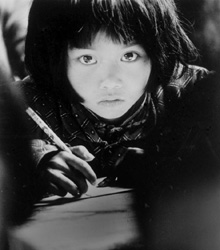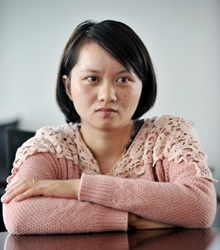|
 |
 |
|
WIDE-EYED PUPIL: A photo of Su Mingjuan taken by Xie Hailong in 1991 (XINHUA) |
LEND A HELPING HAND: Su Mingjuan has grown up and works in a bank after graduating from college (CFP) |
Gaining momentum
In 1991, photographer Xie Hailong, who was just a college student at the time, took a series of photos of school children in poor areas for the project. Among the photos, a girl holding a pencil and looking up from her desk with wide eyes soon became the image of Project Hope.
The girl, Su Mingjuan, is from a village in Jinzhai County of east China's Anhui Province. Born in 1983, Su was in primary school when Xie took the photo in her class. At that time, she needed to pay 100 yuan ($15.87) every semester for the school fee, but her family's farmland could only make enough to feed the family for three months.
With the help of Project Hope, Su got the chance to continue her education and in 2003 she passed the national college entrance exam and entered Anhui University. Now she is working in the Anhui Branch of the Industry and Commerce Bank of China.
"I know how important education is for a person," said Su. "Without Project Hope, there would have been no way for me to be who I am now."
Zeng Long, who was also sponsored by Project Hope, is also from Jinzhai County. With the aid from the project, Zeng entered China's prestigious Tsinghua University in 2001 and now holds a doctoral degree in physics.
"For me, Project Hope is like a boat, carrying me to the bank of knowledge, which was inaccessible to me before," said Zeng. "I hope I can also serve as that kind of boat to more kids in the future."
Jinzhai Hope School, where Zeng attended, was the first primary school supported by Project Hope in Anhui. In the past, there were not even enough chairs and desks, but now it has developed into a five-floor building with a library, multi-media classrooms and labs that serves more than 1,000 students.
In June 1995, the first Middle School under the project's support—the Shanghai Bell Nationality Hope Middle School—began construction in Wangcun Town, Yongshun County, central China's Hunan Province.
By the end of 2013, 9.76 billion yuan ($1.59 billion) had been donated through Project Hope, supporting more than 4.9 million students and building 18,335 primary schools, according to the official website of the China Youth Development Foundation.
In order to supervise donations, six levels of Project Hope management were established in 1994: national, provincial, prefecture, county, town and school. A short time later, the China Youth Development Foundation established the computerized Project Hope Management Information System to ensure a strict management system subject to annual audits. The foundation has also introduced the Project Hope Social Supervision Day to ensure the standardization and transparency of the management system.
Email us at: yuanyuan@bjreview.com | 